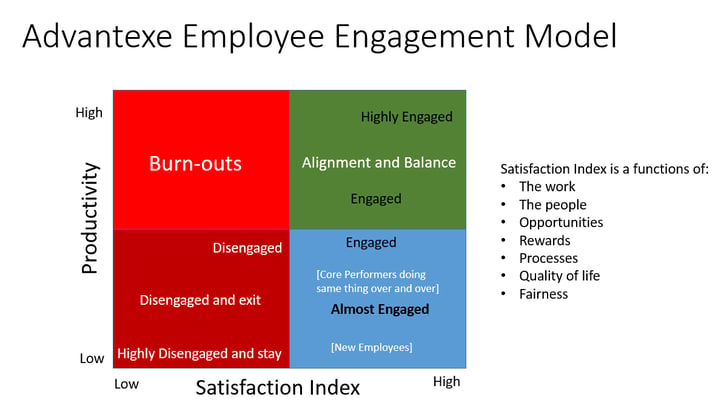Every once in a while during a Business Leadership training session the intensity level of an  application discussion gets so intense that we lose ourselves in the learning. During a deep conversation this week, one of my participants in a High Potential Leader program used a term that I had never heard of when she was describing her most frustrating current leadership situation. “I am dealing with a team of people who I call the ‘Almost Engaged’ and I don’t know what to do with them.” The entire group of 22 participants was curious about the term “Almost Engaged” and asked her to explain and define. She shared and described a type of employee who seems very happy with their jobs but aren’t producing at the levels they should or could be. “They love coming to work, they are on time, they are happy, but they just aren’t that productive.”
application discussion gets so intense that we lose ourselves in the learning. During a deep conversation this week, one of my participants in a High Potential Leader program used a term that I had never heard of when she was describing her most frustrating current leadership situation. “I am dealing with a team of people who I call the ‘Almost Engaged’ and I don’t know what to do with them.” The entire group of 22 participants was curious about the term “Almost Engaged” and asked her to explain and define. She shared and described a type of employee who seems very happy with their jobs but aren’t producing at the levels they should or could be. “They love coming to work, they are on time, they are happy, but they just aren’t that productive.”
We talked about this interesting scenario for a while as this conversation was supposed to be the preparation for their Business Leadership simulation workshop that teaches participants that leadership is equal to the execution of their business strategy. In this simulation experience, participants can’t lead effectively unless the people on their live simulation team and in their computer-based business simulation are engaged and productive.
After the session, I did some more research and developed this graph to try to explain what is an “Almost Engaged” employee and how to lift this person from being almost engaged to being fully engaged; while hopefully avoiding becoming totally disengaged!

For many years, we have used an employee engagement algorithm that includes a look at the work, the people, the opportunities, the rewards, the processes, the quality of life, and the fairness of the organization. In this matrix, someone who is almost engaged is more than a new employee but not yet producing to the highest expectations. The main thing leaders want to avoid in this situation is ignoring them because they seem “happy.” By definition, they are doing the same basic things over and over again and in the long run, for any business strategy, that could be the recipe for disaster. Essentially what this means is the pay is too good and there is no accountability to perform at higher levels. The “Almost Engaged” workers almost never quits and they block valuable slots for new people to come in and grow to higher levels.
Strategies for lifting up the “Almost Engaged”
Take a moment to think about your company and teams to see if there are any “almost engaged” people in your world. If you have any, here are 5 simple ideas…
Training
One of the most probable reasons for underperformance of a highly satisfied employees is training. Think about it; for the past few years many organizations have cut their training budgets and people simply haven’t had access to the skills they need to be effective.
Suggestion: Have a conversation with the employee and determine a best path for creating a development plan and acquiring training.
Stretch Goals
Take a moment to review the goals that the Almost Engaged employee currently has. If they don’t have goals, then that could be the main issue!
Suggestion: Have a conversation with the employee and set some stretch goals that include a couple of “check-in” conversations.
More variable compensation
If it seem that the Almost Engaged employee is too comfortable, then maybe there needs to be more variable compensation.
Suggestion: Reduce the base salary and increase the opportunity to make more money through bonuses and other variable compensation.
Opportunity for advancement
Check to see when the last time there was a conversation about advancement and the employee’s future.
Suggestion: Have a positive conversation about the employee’s goals and desires and where they want their career to go. If there is no real desire for advancement, then this really may be the wrong person for the job.
Performance management
Pay special attention to the core elements of a good performance management system including regular performance conversations and reviews.
Suggestion: Make sure there is a core and regular performance management process. If not, make this a priority.




